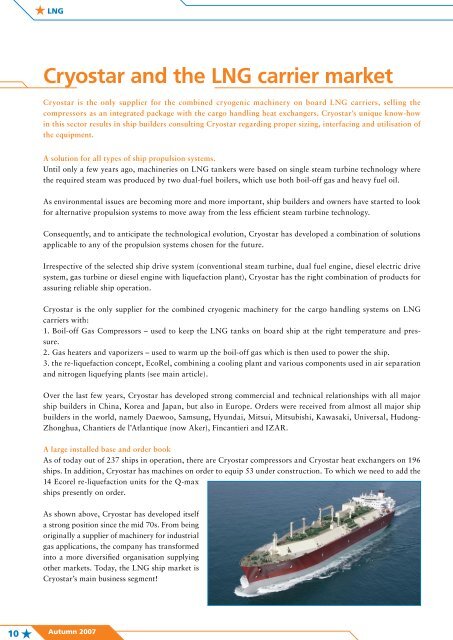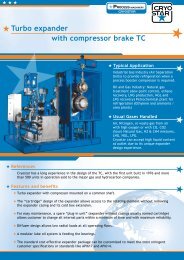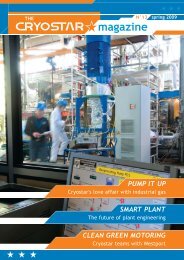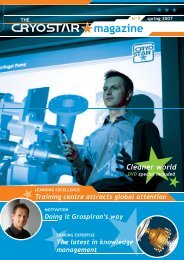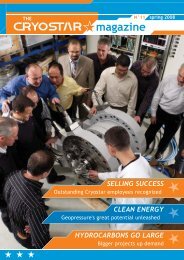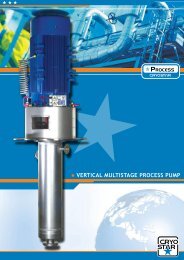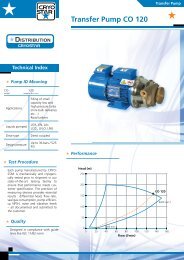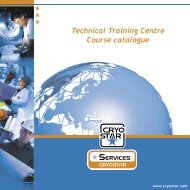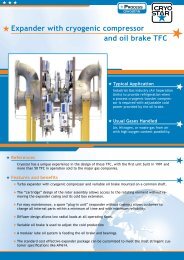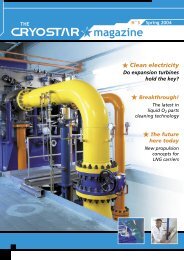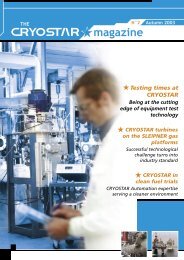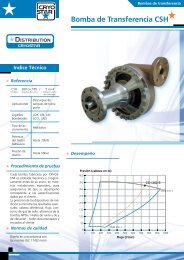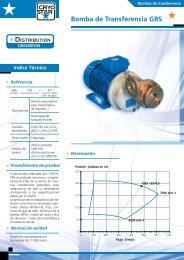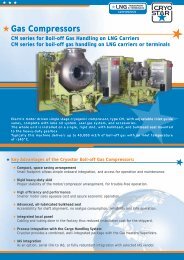The Cryostar Magazine N°10 : pdf file
The Cryostar Magazine N°10 : pdf file
The Cryostar Magazine N°10 : pdf file
Create successful ePaper yourself
Turn your PDF publications into a flip-book with our unique Google optimized e-Paper software.
LNG<br />
<strong>Cryostar</strong> and the LNG carrier market<br />
<strong>Cryostar</strong> is the only supplier for the combined cryogenic machinery on board LNG carriers, selling the<br />
compressors as an integrated package with the cargo handling heat exchangers. <strong>Cryostar</strong>’s unique know-how<br />
in this sector results in ship builders consulting <strong>Cryostar</strong> regarding proper sizing, interfacing and utilisation of<br />
the equipment.<br />
A solution for all types of ship propulsion systems.<br />
Until only a few years ago, machineries on LNG tankers were based on single steam turbine technology where<br />
the required steam was produced by two dual-fuel boilers, which use both boil-off gas and heavy fuel oil.<br />
As environmental issues are becoming more and more important, ship builders and owners have started to look<br />
for alternative propulsion systems to move away from the less efficient steam turbine technology.<br />
Consequently, and to anticipate the technological evolution, <strong>Cryostar</strong> has developed a combination of solutions<br />
applicable to any of the propulsion systems chosen for the future.<br />
Irrespective of the selected ship drive system (conventional steam turbine, dual fuel engine, diesel electric drive<br />
system, gas turbine or diesel engine with liquefaction plant), <strong>Cryostar</strong> has the right combination of products for<br />
assuring reliable ship operation.<br />
<strong>Cryostar</strong> is the only supplier for the combined cryogenic machinery for the cargo handling systems on LNG<br />
carriers with:<br />
1. Boil-off Gas Compressors – used to keep the LNG tanks on board ship at the right temperature and pressure.<br />
2. Gas heaters and vaporizers – used to warm up the boil-off gas which is then used to power the ship.<br />
3. the re-liquefaction concept, EcoRel, combining a cooling plant and various components used in air separation<br />
and nitrogen liquefying plants (see main article).<br />
Over the last few years, <strong>Cryostar</strong> has developed strong commercial and technical relationships with all major<br />
ship builders in China, Korea and Japan, but also in Europe. Orders were received from almost all major ship<br />
builders in the world, namely Daewoo, Samsung, Hyundai, Mitsui, Mitsubishi, Kawasaki, Universal, Hudong-<br />
Zhonghua, Chantiers de l’Atlantique (now Aker), Fincantieri and IZAR.<br />
A large installed base and order book<br />
As of today out of 237 ships in operation, there are <strong>Cryostar</strong> compressors and <strong>Cryostar</strong> heat exchangers on 196<br />
ships. In addition, <strong>Cryostar</strong> has machines on order to equip 53 under construction. To which we need to add the<br />
14 Ecorel re-liquefaction units for the Q-max<br />
ships presently on order.<br />
As shown above, <strong>Cryostar</strong> has developed itself<br />
a strong position since the mid 70s. From being<br />
originally a supplier of machinery for industrial<br />
gas applications, the company has transformed<br />
into a more diversified organisation supplying<br />
other markets. Today, the LNG ship market is<br />
<strong>Cryostar</strong>’s main business segment!<br />
10<br />
Autumn 2007


